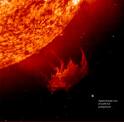Spacecraft Launched By NASA To Study Solar Wind
 With the aim to study the weakening solar wind that protects planets in the solar system from dangerous cosmic rays, the Interstellar Boundary Explorer (Ibex) was launched by Ibex.
With the aim to study the weakening solar wind that protects planets in the solar system from dangerous cosmic rays, the Interstellar Boundary Explorer (Ibex) was launched by Ibex.
The Ibex spacecraft will carry out very extremely high-altitude orbits above Earth over the next two years, in order to examine and capture first images of processes taking place at the interstellar boundary - the farthest reaches of the solar system.
According to principal investigator David J. McComas, “The interstellar boundary regions are critical because they shield us from the vast majority of dangerous galactic cosmic rays, which otherwise would penetrate into earth's orbit and make human spaceflight much more dangerous.”
The satellites must be launched with caution, since cosmic rays impose great health risks to astronauts and also can crate chaos with electronics.
It might be confirmed by Ibex that the sun’s protective bubble also called the heliosphere that surrounds the solar system; is shrinking and weakening. Furthermore, Ibex will also be the first spacecraft to actually witness the connections between the hot solar wind that crashes into the cold expanse of space.
“Ibex was launched aboard a Pegasus rocket, NASA's smallest orbital vehicle, which was dropped from under the wing of an L-1011 aircraft flying over the Pacific Ocean. The rocket would carry Ibex to an orbit about 200,000 miles above Earth,” informed Nancy Crooker, a research professor at Boston University.